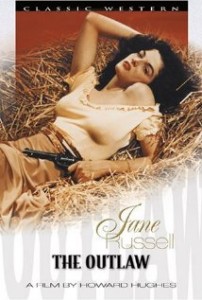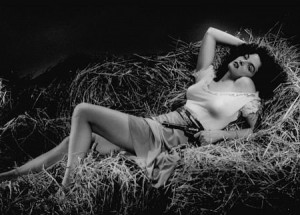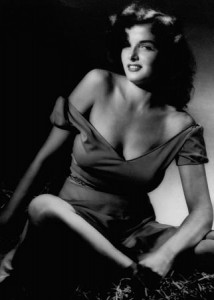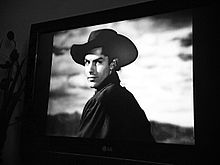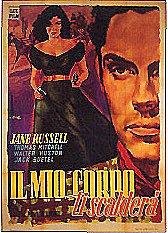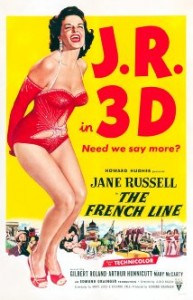The Outlaw **** (1943, Jane Russell, Jack Buetel, Thomas Mitchell, Walter Huston) – Classic Movie Review 1672
Doc Holliday (Walter Huston) welcomes Billy the Kid (Jack Beutel, or correctly Buetel) into his ranch where Billy forcibly romps in the hay with Doc’s mistress, a big-breasted country woman called Rio McDonald (Jane Russell) whose brother he’s killed. Sheriff Pat Garrett (Thomas Mitchell), bent on arresting Billy, shoots and injures him, but Rio revives him and they marry.
Producer Howard Hughes effectively showcases his glorious 18-year-old discovery Jane Russell in his controversial, sexed-up Western, an offbeat, fascinating yarn, with some high-flown tongue-in-cheek talk in a totally unhistorical, muddled screenplay. The real-life story in which Billy the Kid was killed by Pat Garrett in 1881 and Doc Holliday died in bed of tuberculosis in 1887, is obviously an inconvenience to screenplay writer Jules Furthman. And, alas, the movie was hardly helped by its pre-release cutting.
However, Gregg Toland’s atmospheric black and white cinematography is an enormous asset, giving the film a distinction and class it lacks elsewhere. Showy though Hughes’s protégés Russell and Beutel are, their inexperience betrays them (though Russell’s turn as a vivacious vixen is mighty alluring), and it’s the practised veteran scene-stealers Huston and Mitchell who take the acting honours.
The censorship row caused by the lingering shots of Russell’s bosom held up the movie’s release for five years and it was finally shown in a cut version. It was filmed in 1941, but the American Production Code refused to give it a Seal of Approval. Later it was screened briefly in 1943 under the auspices of United Artists and withdrawn.
The Outlaw was re-released in San Francisco on 23 April 1946 but the cinema owner was arrested for showing a film supposedly ‘offensive to decency’. The Motion Picture Association of America alleged that Hughes switched prints and didn’t screen their approved version, so he resigned from the MPAA and filed a $1million lawsuit against them. He lost the suit and his appeals, but United Artists continued to roadshow the film in 1946 and 1947 and it set records. Its ban in New York was finally lifted and the movie shown on 11 September 1947.
By the time it received a proper full release in 1948 under the auspices of RKO, the studio that Hughes had just bought, the film was minus such torrid scenes as the one where a thrusting-topped Russell strips for bed to warm up the ailing hero. Nevertheless the film was still publicised for its sexiness and notoriety.
Though the publicity all surrounded Russell, it seems that Hughes was more interested in Jack Beutel or Buetel (born Warren Higgins). But his career was more or less killed by Hughes, who allowed him virtually no film work for the rest of their exclusive contract. In 1951, he appeared in Best of the Badmen, his first film in 11 years. By the early 1950s when Buetel was a freelance, he was little more than a has-been. Neither man told the story. Buetel made only five other movies, all Westerns, and appeared as a guest in various TV shows, mostly Westerns. His last acting role was in a 1961 episode of Wagon Train.
Russell’s first general release feature was The Young Widow in 1946.
© Derek Winnert 2014 Classic Movie Review 1672
Check out more reviews on http://derekwinnert.com/

